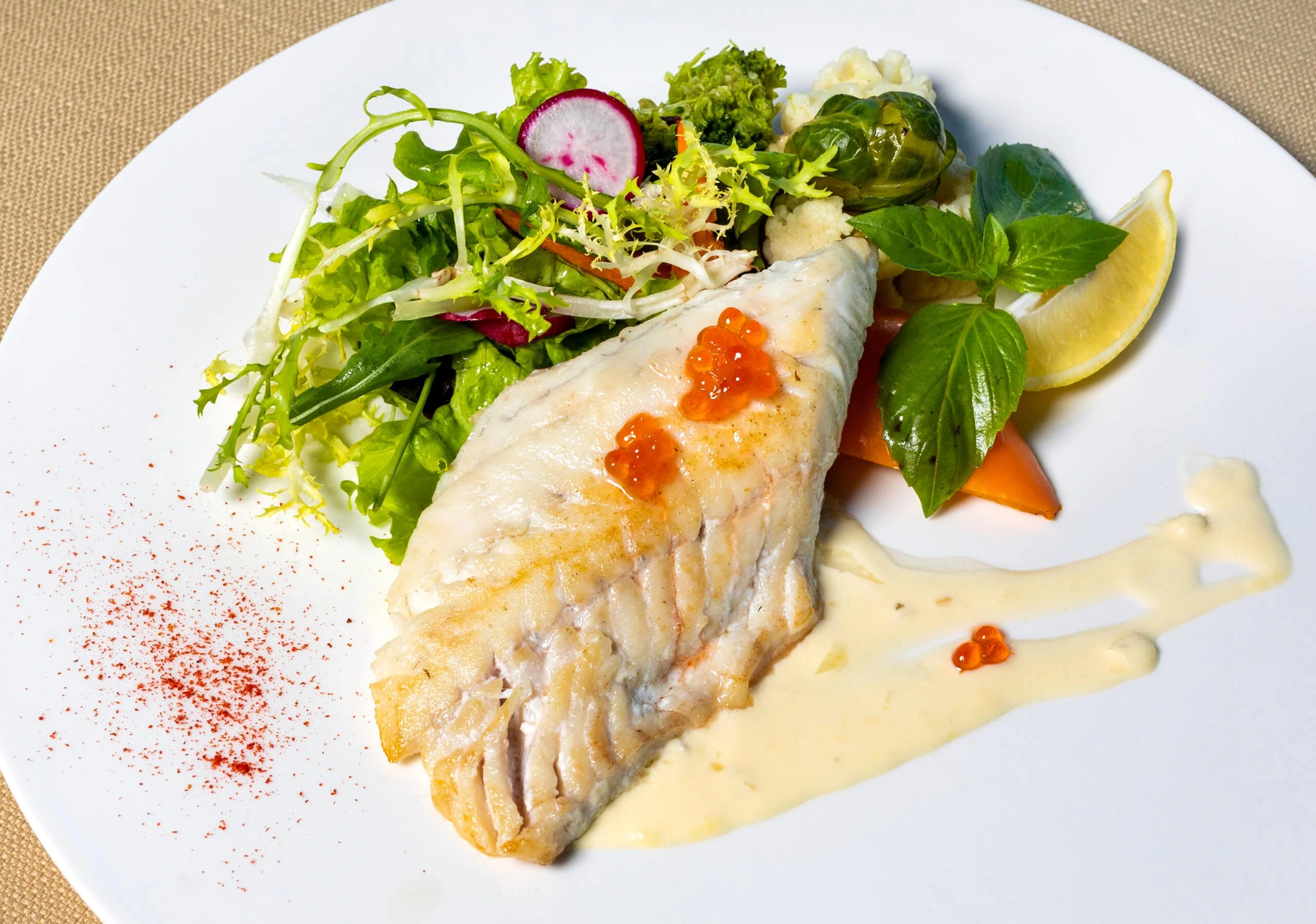Learn how to make simple pan-seared halibut, including how to buy the freshest fish, serving, and storage suggestions.
Halibut may not be the most common seafood dish to prepare at home. However, it just might be easier to make than you think. Not to mention, it’s delicious, with a flaky and tender texture that pairs well with many different side dishes and flavors.
How you make pan-seared halibut? First, prepare a simple marinade and seal the fish in a plastic bag to infuse with flavor for 30 minutes to an hour and a half. Then gently sauté the fish in a hot skillet with olive oil for 5 minutes over high heat. Next, reduce the heat and finish cooking for 5 minutes over medium heat. Finally, plate and enjoy your delicious seafood dinner.
But before you jump into the kitchen, let’s dig a bit deeper into everything you need to know about buying, preparing and cooking halibut on the stove.
Tips to buy the best halibut
If this is your first time buying halibut, or you’re just wondering how to know that you’re getting the freshest catch for dinner, follow a few simple fish buying tips.
The very first thing you have to take into account when you buy halibut is seasonality. Halibut is a warm-weather fish, which meats that it is better to purchase it during the spring and summer in the northern hemisphere. Fall and winter halibut won’t be as fresh or of the highest quality, as it most likely had to travel from the southern hemisphere. The longer any variety of seafood has been out of the water, the less fresh it is. No matter what time of year it is, always ask your fishmonger when the catch arrived at his store. It’s always best to buy the fish that arrived that day.
Once you have determined that timing is right for the freshness factor, you still want to take a closer look at the fish itself. Halibut should have a uniform pearly white color. Avoid discolored or uneven coloration or fish that appears green, gray, red or yellow.
Red and yellow colors, in particular, are an indication that the fish wasn’t properly treated after it was caught. Fish must be gutted as soon as it’s brought in from the water. Otherwise, the intestines can cause what’s known as “belly burn” on the fish flesh. This is a sign of rot and mistreatment and should always be avoided.
The freshet piece of halibut will have a shiny white appearance and firm, tight flesh. Avoid fish that looks dried out or has gapping between the flakes. Give it a smell as the final fool-proof test of freshness. As will all seafood, your halibut should have very little odor, something like the sea and absolutely nothing fish.
Can I freeze halibut?
Yes, you can freeze halibut before it’s cooked. Simply wrap the fish tightly in plastic wrap and store in an airtight bag or container for extra freshness. Freeze for up to two months.
When you’re ready to cook the fish, let it defrost overnight in the fridge and cook using the following recipe for easy pan-seared halibut.
How to make pan-seared halibut
Make easy pan-seared halibut for dinner tonight with your beautiful fresh piece of fish and a few other simple ingredients and steps.
Here’s how to do it:
Ingredients
Start by assembling the following ingredients to marinade and cook the fish:
- 4 halibut fillets with no skin (have the fishmonger remove the skin before you buy)
- 3 minced garlic cloves
- 6 tablespoons of olive oil
- 1 teaspoon of dried basil
- 2 tablespoons of lemon juice
- 1 teaspoon of salt
- 1 teaspoon of pepper
Note that this recipe makes enough for four. You can easily double or half the recipe to suit your needs.
Prepping the halibut
Step 1: Prepare the marinade
The best way to marinate fish or meat is with a large gallon-sized zip-top bag.
To make the marinade for pan-seared halibut, add 6 tablespoons of olive oil, 3 cloves of garlic, 1 teaspoon of dried basil, 2 tablespoons of lemon juice, 1 teaspoon of salt, and 1 teaspoon of pepper to the bag. Thoroughly mix everything together until it’s uniform.
Step 2: Marinate the halibut
Next, carefully place the halibut fillets inside the bag with the marinade. Seal the bag and put it in the fridge.
Let the halibut marinate for at least, 30 minutes. The longer you leave it there the better it will taste. However, do not marinate the fish for more than two hours. This can start to “cook” the fish and will result in a poor texture.
Cooking the halibut
Step 1: Heat a cast-iron skillet
After your fish has marinated, remove it from the fridge and let it sit on the counter for a few minutes while you prepare to cook it.
The best tool to pan-sear your halibut is with a large cast-iron skillet. We recommend this 12″ cast iron skillet if you don’t have one. This material holds heat well and evenly for a thorough cook. However, if you don’t have a good cast-iron pan, you can also use a non-stick or stainless steel pan. As always, bigger is better to give yourself plenty of room to sear the fish without over-crowding your pan.
Heat the skillet over high heat. Once the skillet is hot, drizzle it with olive oil. Swirl the pan so the oil coats the surface completely in a thin layer. Then wait until the oil is just starting to smoke before you move onto the next step.
Step 2: Cook the halibut
Remove the fish from the bag with the marinade and discard the excess marinade. Use a fish spatula to carefully place the fish in the hot skillet. Cook on the first side for three minutes, then flip and cook for another three minutes on the other side. Season each side with salt and pepper as you go.
Step 3: Keep cooking the halibut
Once you have seared both sides of the fish over high heat, reduce the heat to medium. Now cook for another three minutes per side. This lower heat step allows the fish to cook through in the center.
Step 4: Wait and serve
Now check if the halibut is finished cooking. In order to do this, check the thickest part of one of the fillets with a fork. If it flakes easily and looks opaque in the center, it’s time to eat! Otherwise, continue cooking for a minute or two.
Once the halibut is done, plate right away! Fish will overcook if you keep it in the pan, even if you have turned off the heat.
How should halibut be cooked?
There are many ways you can cook halibut. You can grill it, bake it, and steam it, among other methods. Pan-searing halibut, however, is an easy and tasty way to cook the fish that gives you total control over the process. Because the cooking happens in a skillet on the stove, you can watch the fish to prevent it from over-cooking.
If you love pan-seared halibut, go ahead a try a different cooking method next time!
What temperature to cook halibut to?
The most secure way to check that your pan-seared halibut is done cooking is with an instant-read thermometer. Insert the probe into the thickest part of the fish. According to FoodSaftey.Gov, halibut and other seafood is considered safe to eat when it registers 145°F on an internal thermometer.
Halibut is one of those fishes that can be eaten raw. Then again, you can only eat it raw if you are sure it was properly handled. If you suspect there’s some sort of cross-contamination going on, it’s better to cook it.
Simply put, you can eat undercooked halibut – but it’ll be safer if you cook it!
Serving suggestions
Serve your beautiful pan-seared halibut fillets alongside a grain like rice or quinoa and a fresh vegetable side dish like broccoli or cauliflower for a complete meal.
Looking to make an extra special presentation for your next dinner party? Check out this very smart serving platter set.

Pan-Seared Halibut
Equipment
- Zip-lock bag
- Cutting board
- Chef's knife
- Large skillet
- Fish spatula
Ingredients
- 4 halibut fillets with no skin have the fishmonger remove the skin before you buy
- 3 garlic cloves minced
- 6 tablespoons olive oil
- 1 teaspoon dried basil
- 2 tablespoons lemon juice
- 1 teaspoon salt
- 1 teaspoon pepper
Instructions
- To make the marinade for pan-seared halibut, add 6 tablespoons of olive oil, 3 cloves of garlic, 1 teaspoon of dried basil, 2 tablespoons of lemon juice, 1 teaspoon of salt, and 1 teaspoon of pepper to the bag. Thoroughly mix everything together until it’s uniform.
- Carefully place the halibut fillets inside the bag with the marinade. Seal the bag and put it in the fridge.
- Let the halibut marinate for at least, 30 minutes. The longer you leave it there the better it will taste. However, do not marinate the fish for more than two hours. This can start to “cook” the fish and will result in a poor texture.
- Heat the skillet over high heat. Once the skillet is hot, drizzle it with olive oil. Swirl the pan so the oil coats the surface completely in a thin layer.
- Remove the fish from the bag with the marinade and discard the excess marinade. Use a fish spatula to carefully place the fish in the hot skillet.
- Cook on the first side for three minutes, then flip and cook for another three minutes on the other side. Season each side with salt and pepper as you go.
- Reduce the heat to medium. Now cook for another three minutes per side. This lower heat step allows the fish to cook through in the center.
- Check the thickest part of one of the fillets with a fork. If it flakes easily and looks opaque in the center, it’s time to eat! Otherwise, continue cooking for a minute or two.












